
Serviced Offices v Traditional Offices: A Cost-Benefit Analysis
In the ever-evolving landscape of modern business, the choice between serviced and traditional office spaces has become a pivotal decision for companies of all sizes. This choice can significantly impact operational efficiency, financial flexibility, and employee satisfaction. As businesses strive for agility and scalability in a dynamic market, understanding the cost-benefit analysis of serviced offices versus traditional offices is crucial. Let’s delve into the key factors that differentiate these two options, helping you make an informed decision that aligns with your business goals.
Initial Costs and Setup for Offices
Traditional Offices: Opting for traditional typically involves a significant upfront investment. This includes long-term lease agreements, purchasing furniture, setting up infrastructure, and other initial setup costs. The process can be time-consuming and requires a substantial financial commitment before operations even begin.
Serviced Offices: Serviced offices, on the other hand, offer a ready-to-use workspace solution. These come fully equipped with furniture, high-speed internet, and other essential services. The flexibility of short-term leases or pay-as-you-use plans significantly reduces initial capital expenditure, making it an attractive option for startups and established businesses looking for agility.

Ongoing Costs for Traditional & Serviced Offices
Traditional Offices: The financial responsibilities of traditional extend beyond initial setup costs. Businesses are on the hook for ongoing expenses such as utilities, maintenance, cleaning services, and office supplies. Additionally, the management of these tasks can divert resources away from core business activities.
Serviced Offices: Serviced offices bundle these expenses into a single, predictable monthly fee. This not only simplifies budgeting but also ensures that businesses can focus on growth without being bogged down by the day-to-day management of office space. The all-inclusive approach of serviced offices can offer significant savings, particularly for small to medium-sized enterprises (SMEs) that may not have the resources to manage a traditional space efficiently.
Flexibility and Scalability
Traditional Offices: Traditional leases lock businesses into fixed terms, typically ranging from five to ten years. This lack of flexibility can hinder a company’s ability to scale up or down based on current market conditions or business needs, potentially leading to wasted space or cramped quarters.
Serviced Offices: One of the most compelling advantages of serviced spaces is their inherent flexibility. Companies can easily adjust their space requirements as their team grows or downsizes, often with minimal notice. This scalability ensures that businesses pay only for the space they need, when they need it, providing a strategic advantage in a volatile market.
Conclusion
The decision between a serviced or traditional office space ultimately depends on your business’s specific needs, growth plans, and financial considerations. Serviced offices offer unparalleled flexibility, reduced initial and ongoing costs, and valuable networking opportunities, making them an ideal choice for businesses looking to remain agile and competitive in today’s fast-paced market. On the other hand, a traditional one may appeal to businesses with a clear, long-term occupancy plan and a desire for a fully customised space.

As the business world continues to evolve, the benefits of serviced offices become increasingly apparent, offering a strategic advantage for companies aiming to maximise efficiency, minimise costs, and capitalize on growth opportunities. Whether you’re a startup, an SME, or a large corporation, the cost-benefit analysis of serviced versus traditional is a critical exercise in strategic planning and operational efficiency.
